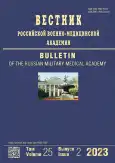Assessment of daily blood pressure parameters in patients after injury
- Authors: Galaktionov D.A.1, Kuchmin A.N.1, Pukhova U.D.1, Nagorny M.B.2, Zubakova M.V.1, Borisov I.M.1
-
Affiliations:
- Kirov Military Medical Academy
- Military Medical Academy of S.M. Kirov
- Issue: Vol 25, No 2 (2023)
- Pages: 203-209
- Section: Original Study Article
- URL: https://journals.rcsi.science/1682-7392/article/view/134100
- DOI: https://doi.org/10.17816/brmma192518
- ID: 134100
Cite item
Abstract
Many studies have highlighted the impact of various significant risk factors on the occurrence of arterial hypertension. However, few papers have examined the effect of psychoemotional factors as important contributors to the risk of arterial hypertension for such a specific population group as contracted servicemen performing military service under conditions of performing special tasks. Furthermore, there is a lack of data on the daily profile of blood pressure in this particular group of individuals. This thesis aims to substantiate the claim that injury, as a risk factor, greatly influences changes in the daily profile of blood pressure. The study examined 118 patients, divided into an experimental group (65 people) and a control group (53 people). The daily profile of blood pressure was assessed using continuous ambulatory blood pressure monitoring. Questionnaires were used to evaluate the quality of sleep, anxiety, and depression. The findings indicated that the patients of the experimental group, following trauma, exhibited a higher index of systolic and diastolic blood pressure duration, while the mean values remained within the normal range. Additionally, these patients more frequently exhibited a blood pressure profile characterized by an insufficient nocturnal decrease in blood pressure, known as “non-dipping”. This could be attributed to impaired sleep quality, as well as subclinically significant manifestations of anxiety and depression caused by stress. The early detection of changes in the index of systolic and diastolic blood pressure duration, along with deviations in the daily blood pressure profile observed through continuous ambulatory blood pressure monitoring, would enable specialists to promptly address alterations in the hemodynamics of these patients and prescribe appropriate therapy. Therefore, psychoemotional stress in people who have experienced trauma is one of the trigger mechanisms for increased blood pressure. If left unaddressed, this can progress to persistent arterial hypertension.
Full Text
##article.viewOnOriginalSite##About the authors
Denis A. Galaktionov
Kirov Military Medical Academy
Author for correspondence.
Email: denisok12@list.ru
ORCID iD: 0000-0003-0514-302X
SPIN-code: 8618-1480
MD, Cand. Sci. (Med.)
Russian Federation, Saint PetersburgAlexey N. Kuchmin
Kirov Military Medical Academy
Email: kuchmin63@mail.ru
ORCID iD: 0000-0003-2888-9625
SPIN-code: 7787-1364
MD, Dr. Sci. (Med.), professor
Russian Federation, Saint PetersburgUlyana D. Pukhova
Kirov Military Medical Academy
Email: uliana.dw@gmail.com
ORCID iD: 0000-0002-9952-3981
SPIN-code: 7392-2647
clinical resident
Russian Federation, Saint PetersburgMikhail B. Nagorny
Military Medical Academy of S.M. Kirov
Email: ilikedm@mail.ru
ORCID iD: 0000-0002-5542-0948
SPIN-code: 1861-8100
MD, Cand. Sci. (Med.)
Russian Federation, Saint PetersburgMaria V. Zubakova
Kirov Military Medical Academy
Email: mariazubakova@gmail.com
ORCID iD: 0000-0003-0554-1650
SPIN-code: 3324-3459
MD, Cand. Sci. (Med.)
Russian Federation, Saint PetersburgIgor M. Borisov
Kirov Military Medical Academy
Email: askbo@mail.com
ORCID iD: 0000-0001-5075-9515
SPIN-code: 8139-5706
MD, Cand. Sci. (Med.)
Russian Federation, Saint PetersburgReferences
- Malyszczak K, Janocha A. The circadian rhythm of blood pressure in patients with panic disorder and generalized anxiety disorder. J Psychosom Res. 2022;161:110999. doi: 10.1016/j.jpsychores.2022.110999
- Kuchmin AN, Ekimov VV, Galaktionov DA, et al. Blood pressure profiles in patients with arterial hypertension and obstructive sleep apnea in different age groups. Arterial Hypertension. 2021;27(5): 530–535. (In Russ.). doi: 10.18705/1607-419Х-2021-27-5-530-535
- Goldie C, Stork B, Bernhardt K, et al. Obstructive sleep apnea among army aircrew. Aerosp Med Hum Perform. 2022;93(5): 415–420. DOI: 103357/AMHP.5990.2022
- Li D, Zeng X, Huang Yi, et al. Increased risk hypertension in young adults in southwest China: impact of the 2017 ACC. AHA high blood pressure guideline. Curr Hypertens Rep. 2019;21(3):21. doi: 10.1007/s11906-019-0926-y
- Kausova GK, Sagidolda GK. Osobennosti razvitiya i techeniya arterial'noi gipertenzii u lits molodogo vozrasta. Vestnik KazNMU. 2020;(3):497–502. (In Russ.).
- Vasyuk YuA, Kotovskaya YuV, Kobalava ZhD. Twenty-four hour monitoring and self-monitoring of blood pressure: a new emphasis of efficient use. Cardiology: News, Opinions, Training. 2013;(1):43–53. (In Russ.).
- Huang Q-F, Yang W-Y, Asayama K, et al. Ambulatory blood pressure monitoring to diagnose and manage hypertension. Hypertension. 2021;77(2):254–264. doi: 10.1161/HYPERTENSIONAHA.120.14591
- Jonson MC, Banaag AL, Condie KJ, et al. New ACC/AHA blood pressure guidelines and the operational readiness of Naval aviators and aircrew. Aerosp Med Hum Perform. 2019;90(4):409–414. DOI: 103357/AMHP.5229.202219
- Kario K, Hoshide S, Mizuno H, et al. Nighttime Blood Pressure Phenotype and Cardiovascular Prognosis: Practitioner-Based Nationwide JAMP Study. Circulation. 2020;142(19):1810–1820. doi: 10.1161/CIRCULATIONAHA.120.049730
- Evdokimov VI, Sivashchenko PP, Grigoriev SG, Ivanov VV. Indicators of dismissal of military personnel of the Armed Forces of the Russian Federation for health reasons in 2003-2018. Bulletin of the Russian Military Medical Academy. 2020;22(2):164–170. (In Russ.). doi: 10.17816/brmma50067
- Kobalava ZD, Konradi AO, Nedogoda SV, et al. Arterial hypertension in adults. Clinical guidelines 2020. Russian Journal of Cardiology. 2020;25(3):149–218. (In Russ.). doi: 10.15829/1560-4071-2020-3-3786
- Kuchmin AN, Yaroslavtsev MYu, Kazachenko AA, et al. Dopolnitel'nye instrumental'nye metody issledovaniya v kardiologii. Saint Petersburg: Lyubavich; 2023. 112 p. (In Russ.).
- Rogoza AN, Oshchepkova EV, Tsagareishvili EV, Gorieva ShB. Sovremennye neinvazivnye metody izmereniya arterial'nogo davleniya dlya diagnostiki arterial'noi gipertonii i otsenki ehffektivnosti antigipertenzivnoi terapii. Moscow: Medika; 2007. 72 p. (In Russ.).
- Kuchmin AN, Kazachenko AA, Galaktionov DA, Ekimov VV. Assessment of sleep quality and drowsiness in patient with obstructive sleep disorders. Orenburg medical herald. 2021;9(4): 27–29. (In Russ.).
- Yunkerov VI, Grigor'ev SG, Rezvantsev MV. Matematiko-statisticheskaya obrabotka dannykh meditsinskikh issledovanii. Saint Petersburg: VMA; 2011. 266 p. (In Russ.).
- Zigmond AS, Snaith RP. The Hospital Anxiety and Depression scale. Acta Psychiatr. Scand. 1983;67(6):361–370. doi: 10.1111/j.1600-0447.1983.tb09716.x
Supplementary files








